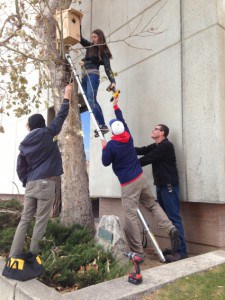Share this article
New student chapter launches kestrel project
Colter Dye was taking Amy Sibul’s undergraduate wildlife ecology and conservation course at the University of Utah a couple of years ago, which required him to take part in a hands-on wildlife ecology project.
Dye volunteered with Hawkwatch International, a nonprofit organization focused on raptor conservation, in order to fulfil the requirement.
“He quickly became useful as a volunteer,” said Sibul, an associate instructor of biology at the University of Utah and the university’s TWS student chapter adviser. He worked on the organization’s Kestrel Citizen Science Project and soon suggested continuing the project on the university’s campus.
Dye then went a step further. Last semester, with help from Sibul, he developed a TWS student chapter for the University of Utah, whose first project would be the kestrel nest box project.

University of Utah students Colter Dye, Jennifer Bridgeman and Matthew Melgaard work with John Estheimer, University of Utah’s arborist, to install a kestrel nest box on campus. Image courtesy of Amy Sibul.
They began their effort by applying for funding from the Sustainable Campus Fund, which provides grant money for projects related to campus sustainability efforts. They used that money for materials to install kestrel nest boxes — they now have a dozen across campus — as well as for a camera that streams kestrel activity in real time.
In addition to around 20 TWS student chapter members who regularly monitor the nest boxes, individuals working near nest boxes also keep tabs on the birds. “They’re aware there’s a box near them, and they’re going to let us know if they see something,” Sibul said. “This will raise awareness about the campus-wide falcon species and get other people to pay attention and be involved.”
The students also placed camera traps at the entrance of four different boxes in order to capture photos of adults entering the boxes. They also plan to install a camera into a nest box that will record live streaming video where they will be able to watch the eggs hatch, see parents tending to the eggs, and bringing food to the nestlings, Sibul said. “We will eventually see them fledge.”
The project is in direct collaboration with Hawkwatch International, and the students are using the same data protocols that the organization uses. Eventually, the kestrels will be banded and marked so their survival success can be monitored, Sibul said.
Header Image: An American kestrel feeds on a white-crowned sparrow. ©Gregory “Slobirdr” Smith








